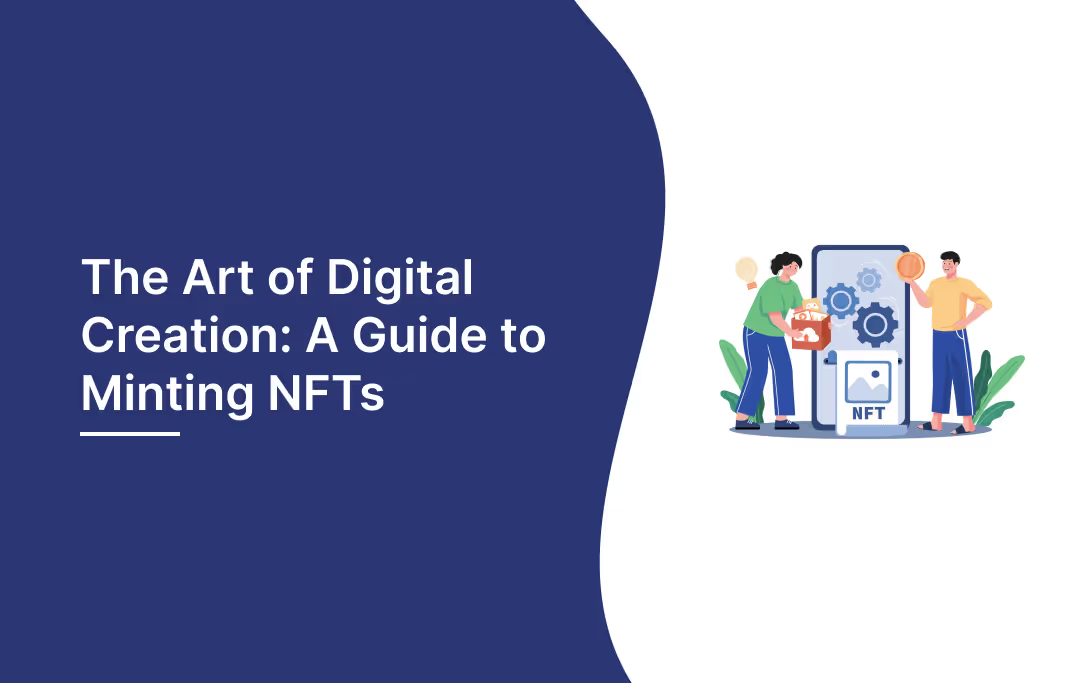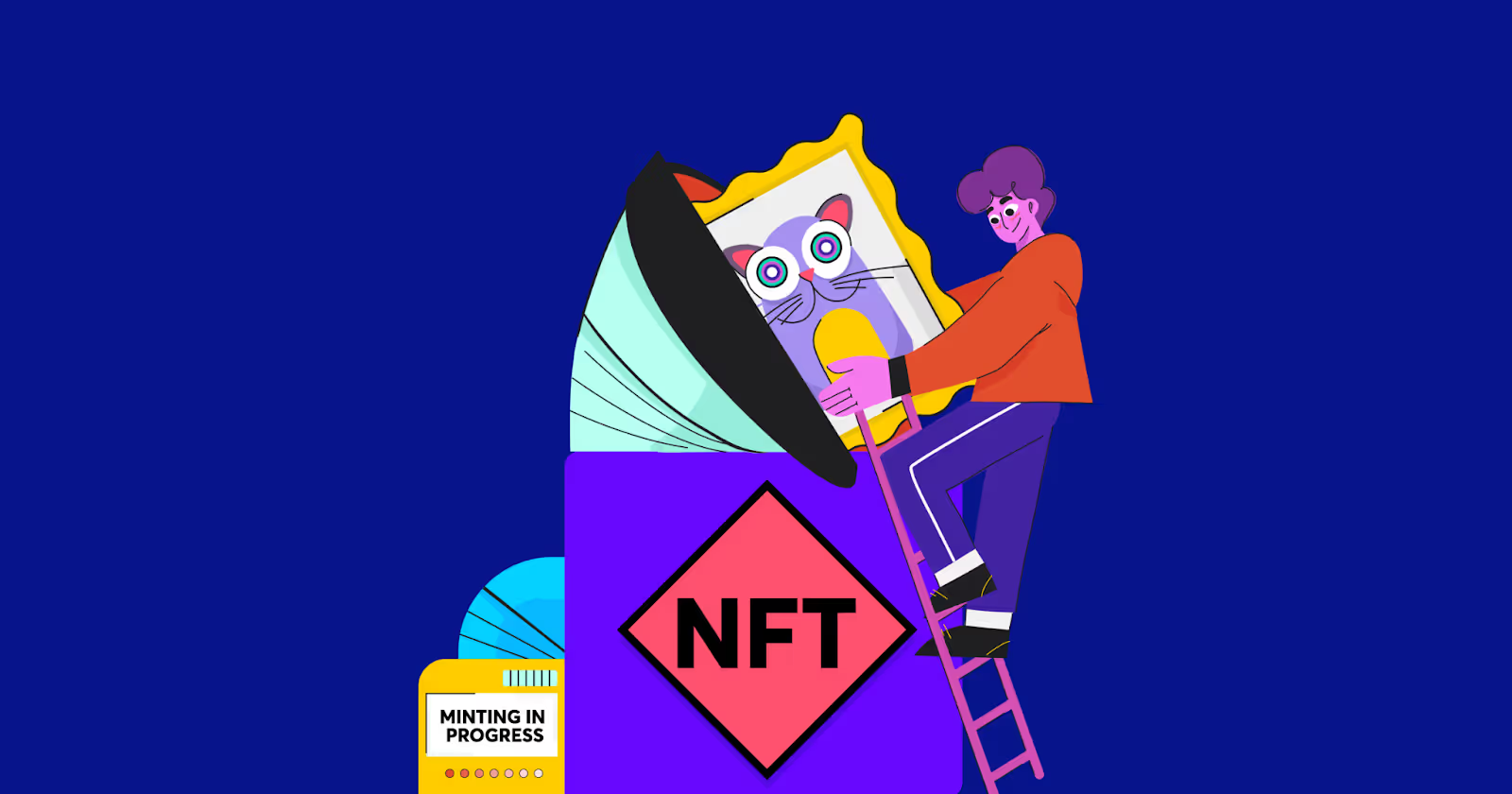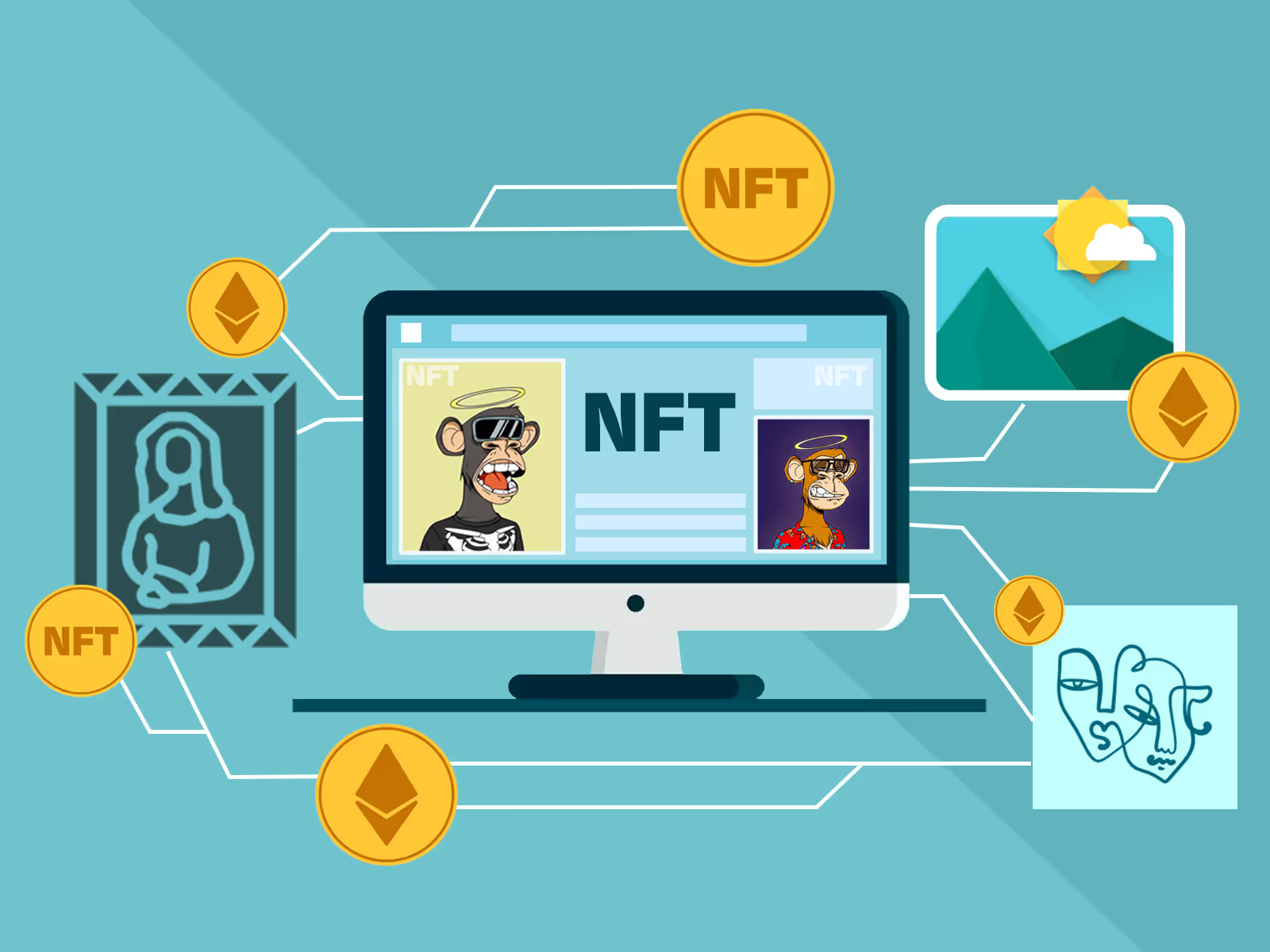.avif)
Calculate Your Crypto
Taxes in Minutes

Introduction
The digital art market has experienced a significant transformation with the emergence of Non-Fungible Tokens (NFTs). These unique digital assets have gained immense popularity, revolutionizing the way creators and collectors interact with digital art. In this blog, we will explore the concept of minting NFTs and the potential they hold for artists, collectors, and the art market as a whole.
What is an NFT?
To understand the process of minting NFTs, it's essential to grasp the concept of Non-Fungible Tokens. Unlike cryptocurrencies such as Bitcoin or Ethereum, which are interchangeable and hold equal value, NFTs are unique digital assets that cannot be exchanged on a one-to-one basis. Each NFT has its own distinct value and properties, making it one-of-a-kind.
The Process of Minting NFTs
Minting an NFT involves creating a unique digital asset and recording its ownership on a blockchain. Here is a step-by-step breakdown of the minting process:
1. Conceptualize and Create the Digital Asset:
Before minting an NFT, artists and creators need to conceptualize and create a digital asset that they want to tokenize. It can include digital artwork, music, videos, virtual real estate, or even virtual goods.
2. Choose the Right Blockchain Platform:
Selecting the appropriate blockchain platform is crucial for minting NFTs. Ethereum is currently the most popular blockchain for NFTs due to its robust smart contract functionality and established NFT standards, such as ERC-721 and ERC-1155. However, other blockchains like Binance Smart Chain and Flow are gaining traction in the NFT space as well.
3. Set Up a Wallet:
Artists and collectors need to set up a digital wallet compatible with the chosen blockchain platform. This wallet will serve as a storage space for NFTs and facilitate transactions.
4. Prepare Metadata and Token Details:
NFTs require metadata that provides additional information about the digital asset. This can include details such as title, description, artwork/image, and any other relevant information. Artists should ensure accurate and compelling metadata to enhance the value and appeal of their NFTs.
5. Choose a Minting Platform:
There are various minting platforms available, which simplify the process of creating and launching NFTs. These platforms often offer user-friendly interfaces, customizable templates, and gas fee estimators to ensure a smooth minting experience.
6. Pay Gas Fees and Mint the NFT:
Minting an NFT involves paying gas fees, which cover the cost of executing transactions on the blockchain. Gas fees can vary depending on the network congestion and complexity of the transaction. Artists need to review and approve the transaction, and once confirmed, the NFT is officially minted.
7. Verify and Store the NFT:
After the minting process, the newly created NFT is assigned a unique token ID and stored on the blockchain. Artists and collectors can verify the authenticity and ownership of the NFT through the blockchain's transparent and immutable records.

Promoting and Selling NFTs
Once the NFT is minted, artists can explore various avenues to promote and sell their digital assets. Online NFT marketplaces provide a platform for artists to showcase their work and connect with potential buyers. Additionally, social media platforms and communities focused on NFTs can help generate exposure and drive sales.
It's important to consider pricing strategies, marketing efforts, and engagement with the NFT community to maximize visibility and potential sales. Collaborations with influential artists, tokenizing limited editions, and offering additional perks or rewards can also attract collectors and increase demand for NFTs.

The Future of NFTs
The rise of NFTs has opened up new possibilities for artists, collectors, and the art market. NFTs offer unique benefits such as provenance, scarcity, and programmable royalties, empowering creators to monetize their work and retain control over its distribution. The integration of NFTs into various industries, including gaming, music, and virtual reality, showcases their potential for broader adoption and innovation.
However, as the NFT market evolves, challenges such as environmental impact, copyright infringement, and market saturation need to be addressed. Continued development of sustainable blockchain solutions, regulatory frameworks, and education about NFTs will contribute to a more robust and inclusive ecosystem.
Creating and Preparing Your Digital Artwork
A. Tips for creating high-quality digital artwork suitable for NFTs
In order to maximize the value and appeal of your NFT artwork, it's essential to create high-quality digital artwork that stands out in the competitive NFT marketplace. Here are some tips to consider:
1. Conceptualize and plan: Begin by brainstorming ideas and concepts for your artwork. Think about what makes it unique and captivating. Sketch out your ideas and refine them before diving into the digital creation process.
2. Use professional-grade tools: Invest in professional-grade digital art software and tools to ensure the highest quality output. Popular options include Adobe Photoshop, Illustrator, Procreate, and Corel Painter. Familiarize yourself with the features and capabilities of your chosen software.
3. Master digital art techniques: Take the time to learn and practice different digital art techniques. Experiment with brushes, layers, blending modes, and other advanced features to add depth, texture, and visual appeal to your artwork.
4. Optimize for display: Consider the intended display format of your NFT artwork. If it will primarily be viewed on digital screens, optimize the colors, contrast, and composition for digital display. Test your artwork on various devices to ensure it looks as intended.
5. Focus on details and resolution: Pay attention to small details and ensure your artwork has a high resolution. This will enhance the overall quality and make it more appealing to potential buyers. Aim for a resolution of at least 300 DPI (dots per inch) to maintain clarity and sharpness.
B. File formats, resolutions, and considerations for optimizing your artwork
Once you've created your digital artwork, it's important to save and optimize it correctly for the NFT marketplace. Here are some key considerations:
1. File formats: The most common file formats for NFT artwork include JPEG, PNG, GIF, and SVG. JPEG and PNG are widely accepted across platforms. GIFs are suitable for animated NFTs, while SVG is ideal for vector-based artwork.
2. Compression and file size: Balance the file size and quality of your artwork. Compress the image to an acceptable level without compromising its visual integrity. Large file sizes may result in longer load times and may discourage potential buyers.
3. Metadata and tokenization: Prepare the necessary metadata for your NFT, including title, description, edition size, and any additional attributes or traits. Each marketplace has specific requirements for metadata, so ensure you follow their guidelines accurately.
Selecting a Marketplace for NFTs
A. Overview of popular NFT marketplaces and their features
With the increasing popularity of NFTs, several marketplaces have emerged to facilitate the buying and selling of digital assets. Here's an overview of some popular NFT marketplaces and their key features:

1. OpenSea: As one of the largest and most well-known NFT marketplaces, OpenSea offers a wide variety of digital assets, including art, collectibles, virtual real estate, and more. It provides an easy-to-use interface for both creators and collectors.
2. Rarible: Rarible is a decentralized marketplace that allows creators to mint and sell their NFTs with minimal fees. It emphasizes community governance and offers unique features like "gasless minting" to reduce transaction costs.
3. SuperRare: SuperRare focuses on curated, limited-edition digital artwork. It has a selective curation process and emphasizes the scarcity and uniqueness of each NFT. The platform offers a higher level of exclusivity and aims to showcase high-quality artwork.
4. Nifty Gateway: Nifty Gateway is known for its focus on digital art and collectibles. It offers a user-friendly experience and features partnerships with well-known artists and brands. Nifty Gateway conducts limited drops and timed releases, creating a sense of urgency for collectors.
B. Factors to consider when choosing a marketplace for minting and selling NFTs
When selecting an NFT marketplace, consider the following factors:
1. User base and visibility: Look for marketplaces with a large and active user base. A wider audience increases the chances of selling your NFTs and gaining exposure as an artist.
2. Fees and costs: Different marketplaces have varying fee structures, including minting fees, transaction fees, and listing fees. Consider the costs associated with each platform and how they align with your budget and revenue expectations.
3. Curation and quality control: Some marketplaces prioritize curation and maintain certain quality standards for listed NFTs. This can impact the visibility and perceived value of your artwork.
4. Community and engagement: Assess the level of community engagement on the marketplace. Are there active forums, social media channels, or networking opportunities? Engaging with the community can help you build connections, gain feedback, and promote your NFTs.
Tax Implications of Minting and Selling NFTs
A. Understanding the tax landscape for NFT transactions
As NFTs gain popularity, it's crucial to be aware of the potential tax implications associated with minting and selling these digital assets. While tax regulations may vary by jurisdiction, here are some general considerations:

1. Capital gains tax: Profits from the sale of NFTs are typically subject to capital gains tax. The tax rate may vary based on the holding period of the NFT and the tax laws of your country or state.
2. Ordinary income tax: In some cases, if you are considered a professional NFT creator or trader, your earnings may be classified as ordinary income rather than capital gains. This could result in different tax treatment and potentially higher tax rates.
B. Reporting requirements and potential tax obligations for creators and collectors
To ensure compliance with tax regulations, consider the following:
1. Record-keeping: Maintain detailed records of all NFT transactions, including purchase dates, sale dates, sale prices, and associated costs. These records will be crucial when calculating your taxable income or gains.

2. Consultation with tax professionals: Tax laws and regulations surrounding NFTs can be complex and subject to change. It's advisable to consult with a qualified tax professional or accountant who is familiar with the specific tax laws in your jurisdiction.
C. Consultation with tax professionals for accurate tax compliance
Given the evolving nature of NFT taxation, it's essential to seek professional guidance to accurately comply with tax regulations. A tax professional can provide personalized advice based on your specific circumstances and help ensure you meet your tax obligations while optimizing your tax position.
Remember, the information provided here is general in nature and not intended as professional tax advice. Always consult with a tax professional to address your unique tax situation.

By understanding the process of creating and preparing NFT artwork, selecting the right marketplace, and staying informed about tax implications, you can navigate the world of NFTs with greater confidence and maximize the potential of your digital assets.
NFT Minting Best Practices and Promotion
A. Tips for effectively promoting and marketing your minted NFTs
Minting an NFT (Non-Fungible Token) is just the beginning of your journey as a digital creator in the world of blockchain. To maximize the visibility and potential value of your NFTs, it's crucial to employ effective promotion and marketing strategies. Here are some best practices to consider:
1. Define your target audience: Identify the niche or community that aligns with your artwork or creative concept. Understanding your audience will help you tailor your promotional efforts and engage with the right people.
2. Build your online presence: Establish a strong online presence across various platforms, such as social media, artist portfolios, and NFT marketplaces. Create dedicated profiles or pages that showcase your work and provide information about your NFT collections.
3. Engage with the NFT community: Participate in discussions, forums, and online communities related to NFTs. Connect with fellow creators, collectors, and enthusiasts. Engaging with the community can help you gain exposure, receive feedback, and build valuable connections.
4. Leverage social media platforms: Utilize popular social media platforms like Twitter, Instagram, and Discord to share updates about your NFT releases, behind-the-scenes content, and interact with your audience. Use relevant hashtags, engage with trending topics, and collaborate with influencers to expand your reach.
5. Collaborate with other artists and projects: Collaborating with other artists or projects can help you tap into their existing audience and gain exposure. Consider collaborations for joint releases, cross-promotion, or creating limited edition NFT collections.
6. Provide exclusive perks or incentives: Offer unique incentives or benefits to collectors who purchase your NFTs. This can include access to exclusive content, early access to future releases, or participation in special events. Providing value-added benefits encourages collectors to engage with your work and increases the perceived value of your NFTs.
B. Engaging with the NFT community and leveraging social media platforms
1. Participate in online discussions: Engage with the NFT community by actively participating in online discussions, forums, and social media groups. Share your knowledge, insights, and experiences related to NFTs. This helps establish your credibility as a creator and builds a supportive network.
2. Attend virtual events and conferences: Stay updated with the latest trends, advancements, and opportunities in the NFT space by attending virtual events, webinars, and conferences. These events provide valuable networking opportunities and allow you to learn from industry leaders and experts.
3. Showcase your NFTs in curated collections: Submit your NFTs to curated collections or galleries on popular NFT marketplaces. Curated collections often attract attention from collectors and can enhance the visibility and discoverability of your artwork.
4. Engage with your collectors: Show appreciation for your collectors by acknowledging their support. Offer personalized messages or rewards to loyal collectors. Building strong relationships with your collectors can result in repeat purchases and word-of-mouth recommendations.
5. Share your creative process: Provide insights into your creative process and share behind-the-scenes content. This helps create a connection between you as a creator and your audience. People often appreciate the story behind an artwork, which can increase its desirability.
Conclusion
In conclusion, minting NFTs opens up a world of opportunities for digital creators to showcase their work, connect with a global audience, and potentially monetize their talent. However, success in the NFT space requires more than just minting tokens; it demands effective promotion and marketing strategies.
By defining your target audience, building your online presence, engaging with the NFT community, and leveraging social media platforms, you can increase the visibility and value of your minted NFTs. Collaborating with other artists, providing exclusive perks, and actively participating in online discussions also contribute to your success as an NFT creator.
As you embark on your NFT journey, it's essential to consider the legal and tax implications associated with minting and selling NFTs. Familiarize yourself with the regulations and obligations in your jurisdiction to ensure compliance.
Unleash your creativity, explore new possibilities, and embrace the world of NFTs. With the right strategies, dedication, and a bit of luck, you can thrive in this exciting and rapidly evolving landscape while responsibly navigating the associated responsibilities.
FAQs
1. What exactly is an NFT?
An NFT, or Non-Fungible Token, is a unique digital asset that represents ownership or proof of authenticity for a specific piece of digital content, such as artwork, music, videos, or virtual goods. Unlike cryptocurrencies like Bitcoin, which are interchangeable, NFTs are distinct and cannot be exchanged on a one-to-one basis.
2. How do I mint an NFT?
Minting an NFT involves creating a digital asset and deploying it onto a blockchain platform that supports NFTs, such as Ethereum or Binance Smart Chain. This process typically requires using a specialized platform or marketplace, where you upload your digital file, add metadata (such as title, description, and artwork details), set a price or royalty structure, and execute the minting transaction.
3. What are the benefits of minting NFTs for digital creators?
Minting NFTs offers several advantages for digital creators. It enables them to establish ownership and authenticity of their digital creations in a transparent and immutable manner. NFTs also provide the potential for monetization through sales, royalties, and secondary market transactions. Additionally, NFTs facilitate direct engagement with fans and collectors, creating new opportunities for connection and community building.
4. How do I determine the value of my NFTs?
The value of an NFT is subjective and influenced by various factors. These factors include the uniqueness and quality of the artwork or content, the reputation and demand for the creator, the rarity of the edition (if applicable), the historical sales performance of similar NFTs, and the current trends and sentiments in the NFT market. Researching similar NFTs, consulting with experts or peers, and observing market dynamics can help inform your pricing decisions.
5. What should I consider regarding copyrights and intellectual property when minting NFTs?
Minting an NFT does not automatically grant or transfer copyright or intellectual property rights. It is crucial to ensure that you have the necessary rights or permissions to mint and sell the digital content associated with your NFTs. If you are using third-party assets, such as licensed images or samples, it is essential to comply with copyright laws and respect the intellectual property of others. Familiarize yourself with copyright regulations and seek legal advice if necessary to protect yourself and respect the rights of others.
All content on Kryptos serves general informational purposes only. It's not intended to replace any professional advice from licensed accountants, attorneys, or certified financial and tax professionals. The information is completed to the best of our knowledge and we at Kryptos do not claim either correctness or accuracy of the same. Before taking any tax position / stance, you should always consider seeking independent legal, financial, taxation or other advice from the professionals. Kryptos is not liable for any loss caused from the use of, or by placing reliance on, the information on this website. Kryptos disclaims any responsibility for the accuracy or adequacy of any positions taken by you in your tax returns. Thank you for being part of our community, and we're excited to continue guiding you on your crypto journey!
| Step | Form | Purpose | Action |
|---|---|---|---|
| 1 | 1099-DA | Reports digital asset sales or exchanges | Use to fill out Form 8949. |
| 2 | Form 1099-MISC | Reports miscellaneous crypto income | Use to fill out Schedule 1 or C. |
| 3 | Form 8949 | Details individual transactions | List each transaction here. |
| 4 | Schedule D | Summarizes capital gains/losses | Transfer totals from Form 8949. |
| 5 | Schedule 1 | Reports miscellaneous income | Include miscellaneous income (if not self-employment). |
| 6 | Schedule C | Reports self-employment income | Include self-employment income and expenses. |
| 7 | Form W-2 | Reports wages (if paid in Bitcoin) | Include wages in total income. |
| 8 | Form 1040 | Primary tax return | Summarize all income, deductions, and tax owed. |
| Date | Event/Requirement |
|---|---|
| January 1, 2025 | Brokers begin tracking and reporting digital asset transactions. |
| February 2026 | Brokers issue Form 1099-DA for the 2025 tax year to taxpayers. |
| April 15, 2026 | Deadline for taxpayers to file their 2025 tax returns with IRS data. |
| Timeline Event | Description |
|---|---|
| Before January 1, 2025 | Taxpayers must identify wallets and accounts containing digital assets and document unused basis. |
| January 1, 2025 | Snapshot date for confirming remaining digital assets in wallets and accounts. |
| March 2025 | Brokers begin issuing Form 1099-DA, reflecting a wallet-specific basis. |
| Before Filing 2025 Tax Returns | Taxpayers must finalize their Safe Harbor Allocation to ensure compliance and avoid penalties. |
| Feature | Use Case Scenario | Technical Details |
|---|---|---|
| Automated Monitoring of Transactions | Alice uses staking on Ethereum 2.0 and yield farming on Uniswap. Kryptos automates tracking of her staking rewards and LP tokens across platforms. | Integrates with Ethereum and Uniswap APIs for real-time tracking and monitoring of transactions. |
| Comprehensive Data Collection | Bob switches between liquidity pools and staking protocols. Kryptos aggregates all transactions, including historical data. | Pulls and consolidates data from multiple sources and supports historical data imports. |
| Advanced Tax Categorization | Carol earns from staking Polkadot and yield farming on Aave. Kryptos categorizes her rewards as ordinary income and investment income. | Uses jurisdiction-specific rules to categorize rewards and guarantee compliance with local tax regulations. |
| Dynamic FMV Calculation | Dave redeems LP tokens for Ethereum and stablecoins. Kryptos calculates the fair market value (FMV) at redemption and during sales. | Updates FMV based on market data and accurately calculates capital gains for transactions. |
| Handling Complex DeFi Transactions | Eve engages in multi-step DeFi transactions. Kryptos tracks value changes and tax implications throughout these processes. | Manages multi-step transactions, including swaps and staking, for comprehensive tax reporting. |
| Real-Time Alerts and Updates | Frank receives alerts on contemporary tax regulations affecting DeFi. Kryptos keeps him updated on relevant changes in tax laws. | Observe regulatory updates and provide real-time alerts about changes in tax regulations. |
| Seamless Tax Reporting Integration | Grace files taxes using TurboTax. Kryptos integrates with TurboTax to import staking and yield farming data easily. | Direct integration with tax software like TurboTax for smooth data import and multi-jurisdictional reporting. |
| Investor Type | Impact of Crypto Tax Updates 2025 |
|---|---|
| Retail Investors | Standardized crypto reporting regulations make tax filing easier, but increased IRS visibility raises the risk of audits. |
| Traders & HFT Users | To ensure crypto tax compliance, the IRS is increasing its scrutiny and requiring precise cost-basis calculations across several exchanges. |
| Defi & Staking Participants | The regulations for reporting crypto transactions for staking rewards, lending, and governance tokens are unclear, and there is a lack of standardization for decentralized platforms. |
| NFT Creators & Buyers | Confusion over crypto capital gains tax in 2025, including the taxation of NFT flips, royalties, and transactions across several blockchains. |
| Crypto Payments & Businesses | Merchants who take Bitcoin, USDC, and other digital assets must track crypto capital gains for each transaction, which increases crypto tax compliance requirements. |
| Event | Consequences | Penalties |
|---|---|---|
| Reporting Failure | The tax authorities can mark uncontrolled revenues and further investigate. | Penalty fines, interest on unpaid taxes and potential fraud fees if they are deliberately occurring. |
| Misreporting CGT | Misreporting CGT Error reporting profits or losses can trigger the IRS audit. | 20% fine on under -ported zodiac signs, as well as tax and interest. |
| Using decentralized exchanges (DEXs) or mixers without records | The IRS can track anonymous transactions and demand documentation. | Possible tax evasion fee and significant fine. |
| Disregarding Bitcoin mining tax liabilities | Mining reward is considered taxable income, and failure of the report can be regarded as tax fraud. | Further tax obligations, punishment and potential legal steps. |
| Foreign crypto holdings: Non-disclosure | Foreign-accepted crypto FATCA may be subject to reporting rules. | Heavy fines (up to $ 10,000 per fracture) or prosecution for intentional non-transport. |
File Your Crypto Tax in Minutes







.avif)
